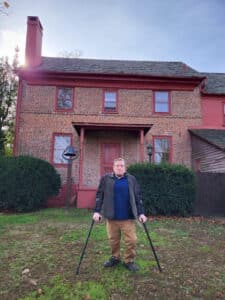It’s become increasingly well-known that Route 130 in Burlington County has earned the dubious distinction of New Jersey’s most dangerous road for pedestrians. In a report released in early March, Tri-State Transportation Campaign has reported nine deaths on Route 130 in Burlington County over the past year, with seven of them coming along a particularly treacherous 7.5 mile stretch between Cinnaminson and Willingboro. And even more tragic is the fact that the deaths continue, with two more pedestrians hit on this section of the highway in the weeks since TSTC released their report, one of them critically injured (later succumbing to his injuries at a hospital), the other killed on the scene. Not only is this scenario utterly unacceptable, it also begs the question “Why?” Why is this situation allowed to continue without remedy or correction?
TSTC’s Matthew Norris and other advocates have consistently laid out common sense fixes that when applied to Route 130, can make this roadway safer to the pedestrians who are imperiled on a daily basis. Reducing the speed limit, painting visible crosswalks, improving traffic signals, installing pedestrian safety islands, and completing sidewalks along the full length of the populated sections of the roadway are reasonable measures that are both simple and cost-effective. And yet, despite a growing number of pedestrian fatalities along this section of Route 130, none of these solutions have been implemented. As stated repeatedly by NJBWC Executive Director Cyndi Steiner, “a culture change” is truly needed in a state where “we have forgotten about accommodating pedestrians,” as she explained in a Philadelphia Inquirer article. Clearly, the problem has nothing to do with lack of engineering know-how and everything to do with attitude and political will.
Among the decision-makers responsible for overseeing this section of roadway, there is no sense of urgency to give pedestrians along Route 130 the degree of safety that they deserve. Instead, a blame-the-victim mentality appears to be in full effect, as public officials shift the blame away from poor traffic and safety planning and toward the decisions made by the pedestrians themselves. Little regard is shown for the travails of these individuals who are forced not only to battle the elements (the two most recent pedestrian fatalities occurred at night with temperatures hovering near the freezing mark) but also to navigate an environment designed with an utter lack of regard for their well-being or convenience.
Instead of calling for appropriate safety redesigns, or urging motorists to cut down on the regular speeding that occurs along this busy section of roadway, Edgewater Park Police Chief Gene DeFillipo relays anecdotes about individuals lifting strollers over the concrete dividers as they cross the roadway as evidence of the notion that pedestrians who fall victim to the dangers of Route 130 lack the “common sense” to properly cross at a safe intersection.
Unfortunately, the reality of Route 130 in Burlington County is that even the intersections don’t provide the degree of safety that pedestrians deserve. Sheila Coleman-Oatman, a 50-year-old Edgewater Park resident, was crossing at the intersection of Route 130 and Cooper Street on December 3rd of last year. Despite being in the crosswalk, she was struck by a vehicle, and then hit again by another vehicle, and died on the scene. Route 130’s most recent victim, 56-year old Richard Price, was also killed in a crosswalk.
Clearly, the issue at hand is not children being carried over dividers by reckless parents. The problem is a roadway that lacks the reasonable design needed to ensure that crossing an intersection is not a life-threatening experience. This stems from a completely unacceptable unwillingness of state and local officials to value the lives of pedestrians in their street layout.
There is a simple reality that often gets lost in auto-centric suburban New Jersey. Not everyone has a car. Some people ride bicycles. Many walk and use public transportation. And yet, their safety and needs are relegated to second-tier status. The stretch of Route 130 between Cinnaminson and Willingboro features an abundance of restaurants, banks, stores, and several NJ Transit bus stops. Accessing this area is more or less a necessity. But pedestrians are expected to run the gauntlet as they use this stretch of road, risking their lives just to catch a bus, or go to work, or get a bite to eat. The fact that an individual is not driving a car is not a valid reason to deny safe access to the basic amenities to which all residents are entitled. We would never tolerate a roadway that was similarly treacherous for drivers. It is simply indefensible to allow pedestrians to be imperiled any more by a scenario that can be easily remedied.
Ultimately, it needs to be acknowledged that as a state highway, the primary responsibility for making Route 130 pedestrian-safe lies with the State of New Jersey. The minor fixes NJDOT has made thus far are simply not enough to stem the tide of pedestrian fatalities. A complete overhaul of traffic flow on this section of Route 130 is needed that would transform the roadway from a speedway to a multi-modal boulevard. Sections of Route 130 that traverse sparsely populated areas might be appropriate as a freeway, but it must be recognized that on this stretch of roadway – with its stores, bus stops, and proximity to residential neighborhoods – the only appropriate option is a complete redesign.
We need the NJDOT to step up to the plate and make this happen. Minor changes on the local level aren’t enough. No advertising or PSA campaign can reach everyone, in particular the many lower-income residents living off-the-grid. Increased police enforcement is unsustainable as a long-term solution. Only one entity can enact the changes necessary to truly remedy the situation. It’s time for the State of New Jersey to take responsibility for its roadway and make Route 130 a safe thoroughfare for everyone.















































































